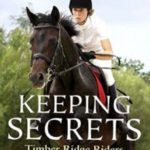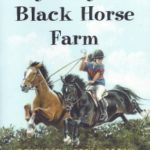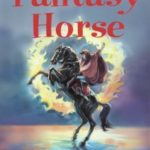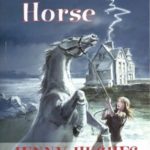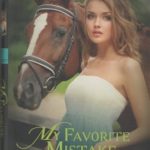aged — more than seven years old. The average lifespan of a horse is 20 to 25 years, although many horses and some horses live for 30 years or more.
aids — the use of hands, legs, seat, weight, and voice to influence a horse; these are natural aids. Artificial aids?whip, spurs?may be used to reinforce the natural aids.
Appaloosa — a spotted horse breed originating in the land of the Nez Perce Indians (northwestern United States). As compared to a Paint or Pinto, Appaloosas have small spots or flecks of white.
Arabian — the oldest pure breed of horse, originating in the Arabian desert. Noted for sensitivity and finely chiseled heads.
barn sour — herd-bound; a dislike of leaving the company of other horses, or of leaving the stable.
bars — the toothless gap between incisors and molars where the bit rests in a horse’s mouth.
billets — leather straps under the flaps of English saddles, to which the buckles of the girth attach.
bit — the metal mouthpiece of a bridle.
blaze — a wide swath of white on a horse’s face, running from above the eyes to the nostrils.
blemish — a scar or defect, usually caused by injury or disease, that doesn’t affect serviceability.
barrel racing — a sport in which the Western horse-and-rider pair gallop around barrels; the rider with the fastest time without overturning a barrel is the winner.
bran mash — a warm meal made of wheat bran, warm water, and a little sweet feed concentrate and chopped apples or carrots; an occasional treat for horses.
breeches — knee-length, fitted riding pants worn with tall English boots.
breed show — a show in which competition is limited to a single breed of horse; the event is sanctioned by that breed’s registry. (For example, the Appaloosa Horse Club sanctions breed shows for Appaloosas.)
broke trained — a “dead broke” horse is a well-trained and obedient one.
canter — the gait between walk and gallop; it consists of three beats followed by a moment of suspension, and has “leads” (in which legs on one side of the horse, front and back, reach farther forward than the legs on the other side).
chaps — leather or suede leggings worn over jeans or riding pants and buckled around the waist. Standard Western show attire; also worn informally by English riders. Half chaps zip or buckle over the lower leg.
cinch — the leather or fabric band that secures a Western saddle to the horse. Some Western saddles have a back cinch, which is not pulled tight. (The English equivalent of a cinch is a girth.)
cloverleaf — the three-barrel pattern that barrel racers run; the path around the barrels resembles a cloverleaf.
Coggins test — a blood test to detect exposure to equine infectious anemia; proof of a “negative Coggins” is often required before a horse is allowed on the grounds of a horse show or a boarding stable.
colic — pain in a horse’s abdomen, ranging from mild to life-threateningly severe. Colic is the number one killer of horses.
colt — a male horse under 4 years old.
competitive trail riding — a sport in which English or Western riders negotiate a preset trail, and are judged on horsemanship and the fitness of their mounts, rather than speed.
conformation — the physical structure and build of a horse.
crest — the top of a horse’s neck, from which the mane grows.
cross country jumping — riding over a course of fences and obstacles constructed over natural terrain.
croup — part of the hindquarters from the highest point to the top of the tail.
curb bit — a bit that uses sidepieces (“shanks”) and a strap or chain under the chin to create leverage on the bars of the mouth; more severe than a snaffle bit.
cutting — a judged event in which the Western horse-and-rider pair must cut one calf from a herd and keep it from returning to the herd.
diagonal — a pair of legs moving in unison at the trot (e.g. right front, left hind). A correctly posting rider (said to be “on the correct diagonal”) rises as the outside front leg reaches forward.
dressage — a French term meaning training. In the discipline of dressage, the English horse-and-rider pair execute gymnastic movements that highlight the horse’s balance, suppleness, cadence, and obedience. Dressage principles, which trace to the earliest days of riding, are used in virtually every form of riding.
endurance riding — contests judged for speed and fitness of the horse over 25-, 50-, and 100-mile courses.
equitation — the art of riding. Equitation classes are judged on the rider’s correctness of form, proper use of aids, and control over the horse; classes are held for English equitation, Western equitation (usually called Western horsemanship), and equitation over fences (sometimes called medal classes).
eventing — a sport, also called combined training, in which English horse-and-rider pairs compete in dressage, cross-country jumping, and jumping in an arena.
farrier — a person who trims and shoes horses’ feet.
fetlock — the joint just above the hoof that seems like an ankle (although it doesn’t correspond to the human ankle).
filly — a female horse under 4years old.
flank — the sensitive area of a horse’s side between his rib cage and hindquarters.
foal — a baby horse under one year old.
forehand — a horse’s head, neck, shoulders, and front legs. A horse traveling “on the forehand” is not carrying enough weight on its hindquarters.
frog — the dense, shock-absorbing, triangular growth on the underside of the hoof.
founder — a serious disease affecting the hooves, often caused by eating too much grain or green grass; especially problematic for ponies. Also called laminitis.
gaits — the different ways in which a horse travels, including walk, trot, canter, and gallop. So-called “gaited horses” have specialty gaits, such as the running walk and the pace.
gaited horse — one possessing a gait beyond the natural walk, trot, and canter; gaited breeds include the American Saddlebred, Icelandic, Missouri Fox Trotter, Paso Fino, Peruvian Paso, Tennessee Walking Horse.
gallop — the fastest gait; it consists of four beats followed by a moment of suspension.
garters — leather straps that buckle under the knee to keep jodhpur pants from riding up.
gelding — a castrated male horse.
girth — the leather or fabric band that secures an English saddle to the horse. (The Western equivalent is a cinch.)
grade horse — one not registered with a breed association, and usually not a purebred.
green inexperienced — may be applied to a horse of any age having limited training, or a rider. The old horseman’s adage says, “Green plus green makes black and blue.”
ground training — schooling of the horse from the ground, rather than from the saddle. Includes in-hand work and longeing.
gymkhana — competitions offering timed obstacle classes and games such as barrel racing and pole bending.
hackamore — a bitless bridle; control comes from the pressure of the noseband on the bridge of the horse’s nose.
halter — the headgear with which a horse is led; made of leather, synthetic webbing, or rope.
halter class — an event in which horses are led in hand and judged on the basis of their conformation.
hand — the unit of measurement for determining the height of horses and ponies. One hand equals four inches; thus a 14.3-hand horse is 59 inches tall from his withers (bony point between the neck and back) to the ground.
hock — the large, angular joint halfway up a horse’s hind leg.
horn — the part of a Western saddle that extends up from the pommel (front), around which a rope may be wrapped and secured.
hunter class — a judged class in which the English horse-and-rider pair must negotiate a course of fences with willingness, regularity, and style.
jodhpurs — ankle-length, fitted English riding pants worn with ankle-high jodhpur boots. This ensemble is popular among young riders.
jog — a slow trot performed by Western horses; also the term for the in-hand evaluation for soundness in hunter classes at some large shows.
jumper class — a class in which the English horse-and-rider pair must negotiate a course of fences; only knock-downs and time penalties count (as opposed to a hunter class, in which proper form is judged).
Kimberwicke — an English bit that combines snaffle rings with a mild curb-bit action.
laminitis — a serious disease affecting the hooves, often caused by eating too much grain or green grass; especially problematic for ponies. Also called founder.
lead — a pattern of footfalls at the canter in which the legs on one side of the horse, front and back, “lead” (reach farther forward than) the legs on the other side. In a circle to the right, the right (inside) legs should lead, and vice versa.
lead-line class — a class for the youngest children in which all mounts are lead by an adult or older child.
leg up — a boost into the saddle, given by someone standing next to the rider and grasping her lower left leg with both hands as the rider bends her leg at the knee.
loafing shed — a three-sided shelter, in a pasture or paddock, which a horse can enter at will for protection from the elements.
longe — to work a horse on a long line (up to 30 foot or more) in a circle around you (rhymes with “sponge”).
lope — a slow canter performed by Western horses.
mare — a female horse four years of age or older.
markings — white areas on a horse’s face and/or legs; commonly used to identify individual animals.
martingale — a piece of equipment designed to effect a horse’s head carriage or to prevent the tossing of the head; attaches to the girth and to the reins or bridle.
medal class — an equitation class over fences.
Morgan — a breed descending from one prepotent sire, Justin Morgan of Vermont. Sturdy and compact, with active gaits.
mouth, hard or soft — describes the horse’s relative responsiveness to the reins.
mucking out — removing manure and soiled bedding from a stall or pen.
near side — the left side of the horse (from which traditionally most handling, and mounting, is done).
off side — the right side of the horse.
paddock — a small pasture or enclosure; larger than a pen.
Paint Horse — a horse, usually of stock type, registered with the American Paint Horse Association; it has a two-toned body color (white patches and areas over the base color).
pastern — the part of the horse’s leg between the hoof and the fetlock.
pelham — a one-piece English bit equipped to handle four reins; a sort of “part snaffle, part curb” bit.
pen — an outdoor enclosure large enough for a horse to walk around in; smaller than a paddock.
Pinto — A horse or pony of varying type, with a two-toned body color (generally large blocks of white), registered with the Pinto Horse Association of America, Inc. A pinto (lower case) is any horse or pony with a two-toned coat.
playday — an informal competition featuring speed events and games, such as pole bending and trotting race.
pleasure — a judged event in which the horse’s smoothness, manner of going, and obedience are judged; there are both English and Western pleasure classes.
pole bending — a timed event in which contestants must weave in and out a line of poles.
poll — the bony bump between a horse’s ears.
pommel — the front, top part of a saddle. The pommel of an English saddle is arched; that of a Western saddle bears a horn.
pony — any equine that measures under 14.2 hands (58 inches) from its withers to the ground. Pony classes at hunter/jumper shows may be divided into small (under 12.2), medium (under 13.2), and large (under 14.2).
Pony of the Americas (POA) — A pony breed created by crossing Shetland ponies with Appaloosa horses; generally sporting Appaloosa coat patterns. POAs are commonly used as children’s mounts.
posting — rising and sitting in the saddle at the trot, in rhythm with the horse’s strides. Posting takes the “bounce” out of the trot. (See diagonal.)
pre-purchase exam — the process of having a veterinarian check your prospective horse or pony for health and soundness; also called a vet check or “vetting.”
pulling back — a bad habit in which the horse pulls back violently on the lead rope when tied, potentially injuring himself and anyone around him.
Quarter Horse — a well-muscled, good-tempered, versatile breed that’s popular among adults and children alike. The American Quarter Horse Association is the largest single-breed registry in the world.
Quarter Pony — a pony of Quarter Horse type and disposition; commonly used as a children’s mount.
rearing — the raising up of a horse onto its hind legs when being led or ridden; a bad habit that should be handled only by a professional.
reins — the leather lines that attach to the bit and are held in the rider’s hands to guide and control a horse.
reined cow horse — a judged event in which the Western horse-and-rider pair must perform tasks related to cattle herding, plus a reining pattern. Also called working cow horse.
reining — a judged event in which the Western horse-and-rider pair perform a pattern of circles and straight lines, with sliding stops and spins in place.
riding sneakers — athletic-styled shoes designed specifically for riding, with steel reinforcement and an adequate heel.
ring sour — the attitude of a horse that doesn’t enjoy being ridden in an arena and looks for ways to leave the ring or quit working.
roping — a timed event in which the Western rider must chase and rope a steer.
school horse — an experienced, usually older horse used as a lesson mount; also called lesson horse. Good school horses make wonderful first mounts, but they are rarely for sale.
schooling show — a “practice” show for novice riders and advanced riders schooling green horses.
Shetland Pony — smallest of the pony breeds, originating in the Shetland Islands.
show jumping — a timed event in which the English horse-and-rider pair must negotiate a course of fences without knocking any part of them down.
showmanship — an in-hand class in which the Western handler is judged on his/her ability to present the horse effectively to the judge.
shying — responding to a sound, movement, or object by suddenly jumping to the side or running off. A horse that shies a lot is said to be “spooky.”
snaffle bit — a bit with a jointed mouthpiece and rings at the ends; works first on the corners of the mouth. Less severe than a curb bit.
spooky, easily startled — a spooky horse is not suitable for a beginning rider of any age.
stallion — an unaltered male horse four years of age or older.
star — a white patch on a horse’s forehead.
stirrup leathers — the straps connecting the stirrups to an English saddle; also known as “leathers.”
stirrups — the part of the saddle that supports a rider’s feet; metal for English saddles (thus often called “stirrup irons”) and wood-and-leather for Western saddles.
tack — the gear used on a horse, e.g. saddles, bridles.
tacking up — saddling and bridling a horse.
topline — the outline of a horse from the top of his head to the top of his tail.
Thoroughbred — an English breed tracing to three Arabian sires. The world’s premier race horse, but also used for a wide range of sports, especially jumping. The word refers specifically to a horse registered with The Jockey Club, and should not be used to denote “purebred.”
trot — the two-beat gait between the walk and the canter.
vaulting — gymnastic maneuvers performed on the back of a cantering horse.
walk — the slowest gait, consisting of four beats.
walk-trot class — a class for beginning riders in which only the walk and trot (and not the canter, or lope) are called for.
Warmblood — a general term for European breeds of sport horses. Examples include Dutch Warmblood, Hanoverian, and Holsteiner.
Welsh Pony — a pony originating in Wales; excellent for riding and commonly used as a children’s mount.
withers — the bony point at the base of the neck, just in front of where the saddle rests. Horses are measured from the top of the withers to the ground.
working cow horse — a judged event in which the horse-and-rider pair must perform tasks related to cattle herding, plus a reining pattern. Also called reined cow horse.
This glossary originally appeared in Growing Up With Horses.



